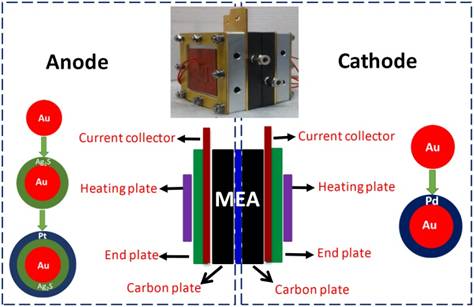The strong growing interest in using direct methanol fuel cells (DMFCs) as portable and mobile power sources is rooted in their desirable features of relatively small environmental footprint, compact system design, and higher volumetric energy densities compared with existing technologies.
Currently, the anode and cathode catalysts of DMFCs are commonly based on platinum (Pt). These catalysts are not selective to methanol oxidation reaction (MOR) at anode or oxygen reduction reaction (ORR) at cathode, and hence any methanol crossover from the anode to the cathode through the PEM can be oxidized by the cathode catalyst. This results in the creation of a mixed potential at the cathode, which significantly degrades the fuel cell performance.
In general, dilute methanol solutions (< 4 M) are often used as fuel for DMFCs in order to inhibit the methanol crossover. However, to compete with lithium-based rechargeable batteries that currently dominate the portable power market, the use of high-concentration methanol (9 M or higher) as fuel is highly demanded to capitalize the high energy density of DMFCs.
Commonly, scientists use various strategies to improve DMFC performance at high concentrations of methanol. These include improving the fuel-feed system, membrane development, modification of electrodes, and water management. Unfortunately, these approaches would not fundamentally overcome this key obstacle, but inevitably complicate the design of the DMFCs and hence increase their cost.
Instead, a research group led by Prof. YANG Jun at Institute of Process Engineering (IPE), Chinese Academy of Sciences (CAS) demonstrates the use of selective electrocatalysts to run a DMFC at methanol concentration up to 15 M.
Upon the deep understanding of the mechanisms of the electrode reactions in DMFCs, they designed and produced noble metal-based heterogeneous nanomaterials with enhanced catalytic activity and high selectivity towards DMFC reactions by sufficiently making use of the structural uniqueness and electronic coupling effects among the different domains of the electrocatalysts so that the DMFCs can be operated well with high-concentration methanol as fuel.
As shown in Fig. 1, ternary Au-Ag2S-Pt nanocomposites with core-shell-shell structures display superior anode selectivity due to the electronic coupling among their different domains, while core-shell Au-Pd nanoparticles with thin Pd shells exhibit excellent cathode selectivity because of the synergistic effects between their Au core and thin Pd shell.

Fig. 1. DMFC assemblies. Schematic illustration showing a DMFC fabricated with selective electrocatalysts at the anode and cathode chambers. Inlet is the photograph of the assembled cell. (Image by YANG Jun)
The as-fabricated DMFC with selective catalysts produces a maximum power density of 89.7 mW cm-2 at a methanol-feed concentration of 10 M, and maintains good performance at methanol concentrations up to 15 M.
The concept using selective electrocatalysts to run a DMFC may shed some light on the design of more cost-effective and efficient DMFC systems. Next, by optimizing the overall size of the catalysts, e.g. using Au nanoclusters with fine diameters as starting materials, further enhancement in activity/selectivity for DMFC reactions might be expected.
This research was financially supported by the National Natural Science Foundation of China (21376247, 21506225, 21573240), and the Center for Mesoscience, IPE, CAS (COM2015A001). Related findings have been published in Science Advances with the title of "A selective electrocatalyst-based direct methanol fuel cell operated at high concentration of methanol" (Science Advances 2017, 3, e1700580).
Contact:
Prof. YANG Jun
State Key Laboratory of Multiphase Complex Systems, IPE, CAS
Beijing 100190, China.
Tel: +86-10-82544915
E-mail: jyang@ipe.ac.cn
 Search
Search




 京公网安备110402500047号
京公网安备110402500047号